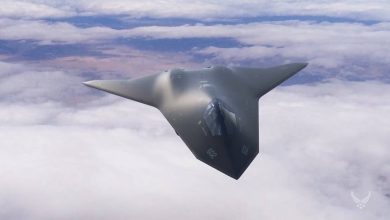Latvia-led drone coalition for Ukraine gains more funding, members

PARIS — The international coalition to supply drones to Ukraine has received almost $600 million in commitments from Western allies, with Italy and France being the latest countries to join the alliance, the Latvian minister of defense said.
The four-month old initiative, which was born in mid-February and now counts 14 participating nations, outlined an ambition to deliver at least one million unmanned aerial vehicle systems to the embattled country.
“The caveat in this goal is to specify that while, yes, quantity is important, so is providing quality systems – so with this number we aren’t only talking about providing one type of drone but the full spectrum of them, including electronic warfare and counter capabilities,” Latvian Defense Minister Andris Spruds said during a panel at the Eurosatory trade show here.
According to the official, the drone alliance has received over €500 million euros ($590 million) in international pledges, which he expects will increase further in the future.
Spruds added that the coalition, which is spearheaded by his home country and the U.K., recently gained two new members – Italy and France – following a meeting of NATO defense ministers in Brussels.
On a national level, Baltic states have accelerated their drone procurement and training programs, with a special focus on first-person-view types, which have come to dominate the battlefield in Ukraine.
“FPV drones are a game-changer for the current and future battlefield – the most expensive pieces of equipment will be destroyed by these cheaper drones,” Linas Idzelis, Commander of Lithuania’s Riflemen’s Union, a paramilitary non-profit organization supported by the Lithuanian government, told the audience.
The officer said that the country is currently training roughly 6,000 cadets on how to use these cost-effective weapons, with a teaching course taking about 60 hours to complete.
According to Arunas Kumpis, a volunteer soldier in Ukraine who also operates FPV drones, one team typically launches between 30 and 35 of these systems daily to hit assigned targets.
The soldier detailed the usual setup of three-person FPV teams in Ukraine, which hide in concealed and entrenched locations such as bunkers and can operate up to 100 meters away from antennas.
These platforms have proven to be a headache for armored vehicles near the frontlines in recent weeks, with reports that the threat even led U.S. officials to request that donated Abrams main battle tanks no longer be deployed to these areas.
“If armored vehicles are 10-15 kilometers from the frontlines many of these drones can generally hit them – you need to move fast as FPVs have a fast reaction time, around one minute to start, and ten minutes to fly to a target,” Kumpis said.
Elisabeth Gosselin-Malo is a Europe correspondent for Defense News. She covers a wide range of topics related to military procurement and international security, and specializes in reporting on the aviation sector. She is based in Milan, Italy.
Read the full article here






